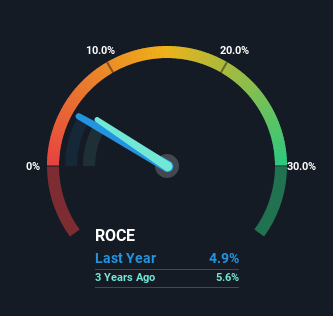- United States
- /
- Auto Components
- /
- NasdaqGS:MPAA
The Returns On Capital At Motorcar Parts of America (NASDAQ:MPAA) Don't Inspire Confidence
Finding a business that has the potential to grow substantially is not easy, but it is possible if we look at a few key financial metrics. Ideally, a business will show two trends; firstly a growing return on capital employed (ROCE) and secondly, an increasing amount of capital employed. Put simply, these types of businesses are compounding machines, meaning they are continually reinvesting their earnings at ever-higher rates of return. However, after investigating Motorcar Parts of America (NASDAQ:MPAA), we don't think it's current trends fit the mold of a multi-bagger.
Understanding Return On Capital Employed (ROCE)
Just to clarify if you're unsure, ROCE is a metric for evaluating how much pre-tax income (in percentage terms) a company earns on the capital invested in its business. The formula for this calculation on Motorcar Parts of America is:
Return on Capital Employed = Earnings Before Interest and Tax (EBIT) ÷ (Total Assets - Current Liabilities)
0.049 = US$29m ÷ (US$1.0b - US$426m) (Based on the trailing twelve months to December 2022).
Therefore, Motorcar Parts of America has an ROCE of 4.9%. Ultimately, that's a low return and it under-performs the Auto Components industry average of 14%.
See our latest analysis for Motorcar Parts of America

Above you can see how the current ROCE for Motorcar Parts of America compares to its prior returns on capital, but there's only so much you can tell from the past. If you'd like, you can check out the forecasts from the analysts covering Motorcar Parts of America here for free.
So How Is Motorcar Parts of America's ROCE Trending?
In terms of Motorcar Parts of America's historical ROCE movements, the trend isn't fantastic. Over the last five years, returns on capital have decreased to 4.9% from 23% five years ago. On the other hand, the company has been employing more capital without a corresponding improvement in sales in the last year, which could suggest these investments are longer term plays. It's worth keeping an eye on the company's earnings from here on to see if these investments do end up contributing to the bottom line.
Another thing to note, Motorcar Parts of America has a high ratio of current liabilities to total assets of 42%. This effectively means that suppliers (or short-term creditors) are funding a large portion of the business, so just be aware that this can introduce some elements of risk. While it's not necessarily a bad thing, it can be beneficial if this ratio is lower.
Our Take On Motorcar Parts of America's ROCE
In summary, Motorcar Parts of America is reinvesting funds back into the business for growth but unfortunately it looks like sales haven't increased much just yet. Since the stock has declined 40% over the last five years, investors may not be too optimistic on this trend improving either. On the whole, we aren't too inspired by the underlying trends and we think there may be better chances of finding a multi-bagger elsewhere.
If you'd like to know more about Motorcar Parts of America, we've spotted 2 warning signs, and 1 of them shouldn't be ignored.
While Motorcar Parts of America may not currently earn the highest returns, we've compiled a list of companies that currently earn more than 25% return on equity. Check out this free list here.
New: Manage All Your Stock Portfolios in One Place
We've created the ultimate portfolio companion for stock investors, and it's free.
• Connect an unlimited number of Portfolios and see your total in one currency
• Be alerted to new Warning Signs or Risks via email or mobile
• Track the Fair Value of your stocks
Have feedback on this article? Concerned about the content? Get in touch with us directly. Alternatively, email editorial-team (at) simplywallst.com.
This article by Simply Wall St is general in nature. We provide commentary based on historical data and analyst forecasts only using an unbiased methodology and our articles are not intended to be financial advice. It does not constitute a recommendation to buy or sell any stock, and does not take account of your objectives, or your financial situation. We aim to bring you long-term focused analysis driven by fundamental data. Note that our analysis may not factor in the latest price-sensitive company announcements or qualitative material. Simply Wall St has no position in any stocks mentioned.
About NasdaqGS:MPAA
Motorcar Parts of America
Manufactures, remanufactures, and distributes heavy-duty truck, industrial, marine, and agricultural application replacement parts in the United States.
Good value with adequate balance sheet.
Similar Companies
Market Insights
Community Narratives




